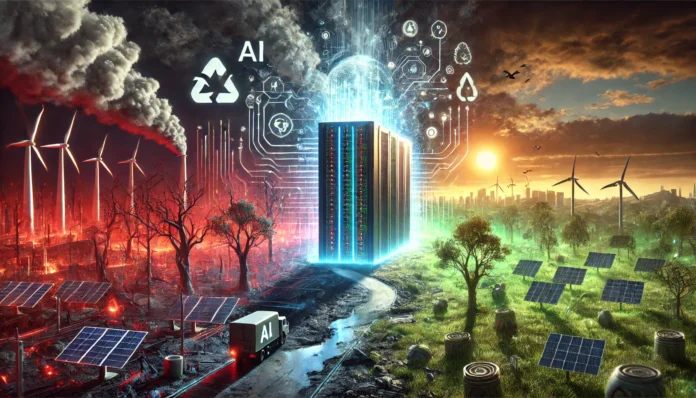Artificial intelligence (AI) is often hailed as a transformative technology with the potential to solve some of the world’s most pressing challenges, including climate change. However, the hidden environmental cost of developing and deploying AI systems raises serious concerns. From the energy-intensive training of AI models to the carbon footprint of data centers, the rapid growth of AI technologies may inadvertently exacerbate the very problems they aim to address.
Energy Demands of AI Development
One of the most significant contributors to AI’s environmental impact is the vast amount of energy required to train and run machine learning models. The process of training a large language model like OpenAI’s GPT or Google’s BERT involves processing massive datasets using powerful computers over weeks or months. This intensive computational effort consumes substantial electricity, often sourced from fossil fuels.
- Case Study: Carbon Emissions of AI Models
A 2019 study from the University of Massachusetts Amherst found that training a single AI model can emit as much carbon dioxide as five cars would over their entire lifetimes. For instance, training BERT, a natural language processing model, was estimated to produce 1,400 pounds of CO2 emissions. This highlights the significant carbon footprint associated with state-of-the-art AI research.
Data Centers: The Silent Culprit
AI development relies heavily on data centers, which house thousands of servers running continuously to process and store data. These centers require enormous amounts of energy for both computation and cooling.
- Example: Google’s Carbon Footprint
While Google has made strides toward sustainability, its operations still contribute significantly to carbon emissions. In 2020, Google reported energy consumption of approximately 15.5 terawatt-hours—more than the annual electricity consumption of some small countries. Despite efforts to use renewable energy, the demand for AI-powered services like Google Search, Google Translate, and YouTube adds pressure on energy resources. - Global Impact
Globally, data centers account for about 1% of electricity demand, and their share is projected to grow as AI adoption expands. This demand creates a paradox: while AI applications can help optimize energy use in some areas, their operation increases energy consumption in others.
E-Waste and Hardware Production
The environmental impact of AI extends beyond energy consumption. Developing and maintaining AI systems require specialized hardware, such as GPUs and TPUs. The production of these components involves mining rare earth metals, a process associated with environmental degradation, habitat destruction, and significant CO2 emissions.
Furthermore, the rapid pace of technological advancement leads to frequent hardware upgrades, contributing to e-waste—a growing environmental crisis. The United Nations estimates that over 50 million metric tons of e-waste are generated annually, a figure exacerbated by AI-driven demand for cutting-edge technology.
Balancing AI Innovation with Sustainability
Despite its environmental drawbacks, AI has the potential to contribute to climate solutions if managed responsibly. For example, AI can optimize energy grids, reduce industrial emissions, and improve renewable energy forecasting. However, striking a balance between innovation and sustainability is critical.
Steps Toward Greener AI
- Energy-Efficient Algorithms: Researchers are developing more efficient AI algorithms that require less computational power without sacrificing performance.
- Renewable Energy Integration: Companies like Google and Microsoft are committing to powering their data centers with 100% renewable energy.
- Carbon Offsetting: Tech firms can offset their emissions by investing in reforestation projects or carbon capture technologies.
- Hardware Recycling: Encouraging recycling and sustainable production practices can reduce the environmental impact of hardware used in AI.
Conclusion
AI offers immense potential to drive positive change, but its environmental impact cannot be overlooked. The energy-intensive nature of training AI models, the carbon footprint of data centers, and the e-waste generated by hardware production are significant contributors to climate change.
As AI technologies continue to evolve, it is crucial for researchers, policymakers, and tech companies to prioritize sustainability. By investing in green energy, developing efficient algorithms, and adopting ethical practices, the tech industry can mitigate AI’s environmental costs and ensure that this transformative technology becomes a tool for combating climate change rather than contributing to it.





